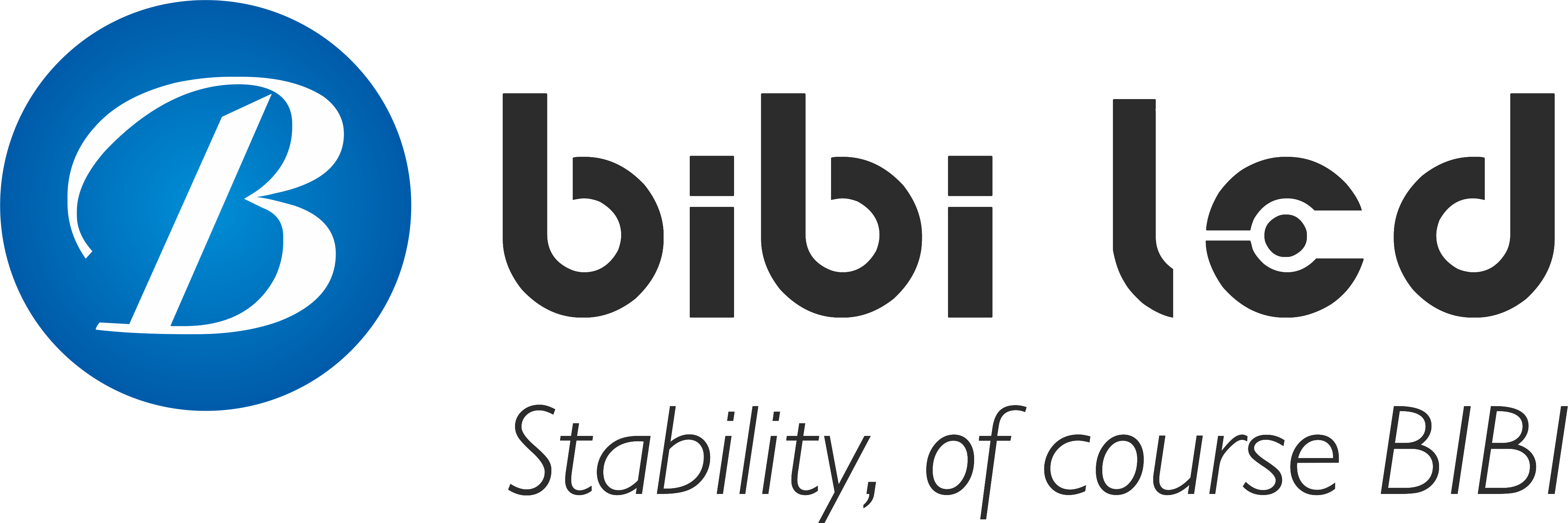序章
テレビスタジオでは、視聴者が番組の現場にいるかのような臨場感あふれる視聴体験をどのように作り出すのでしょうか?
の出現 LEDディスプレイ テレビ番組制作に革命的な変化をもたらしました。
繊細な映像表現から多様なクリエイティブなディスプレイ、観客の参加を促すこと、スタジオレイアウトの最適化まで、LEDディスプレイならではのメリットとは?さあ、探ってみましょう!
目次
利点1:細部まで繊細に表現できる
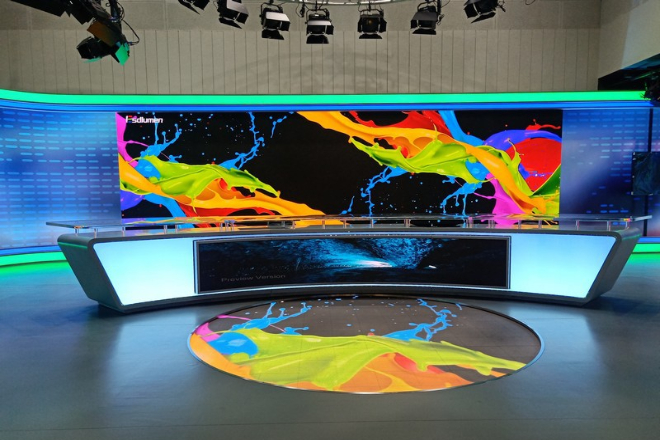
LEDディスプレイはスタジオにおける「高解像度の拡大鏡」のような存在で、映像の細部まで鮮明に映し出します。現在では、多くのLEDディスプレイが4K、さらには8Kといった超高解像度ディスプレイに対応しています。
視聴者の皆さんは、家でテレビを見ながら、まるでその番組の現場にいるような感覚を味わえます。この感覚は本当に素晴らしいです!
1). ライブで スポーツ イベント、詳細がすべて
エキサイティングなサッカーの試合をライブで観戦していると想像してみてください。フィールド上の選手たちのあらゆる動き、走り、そして表情が、高解像度のLEDディスプレイに鮮明に映し出されます。
例えば、2022年カタールワールドカップでは、大型スクリーンに使用されたLEDディスプレイスクリーンにより、観客は選手たちの顔に浮かぶ汗や、目の中の集中力や緊張までもはっきりと見ることができます。
この細部へのこだわりにより、観客はまるでコートのサイドラインに座り、選手たちと一緒に息を合わせ、一緒に試合の情熱を感じているかのように感じます。
2)ニュース番組では鮮明な画像の方が説得力がある
ニュース番組でもこのような高精細な表示効果は必要です。
たとえば、ニュースキャスターが複雑な地図やデータチャートを紹介する場合、超高精細の LED ディスプレイ画面を使用すると、その内容を一目で確認できます。
観客は、小さな単語やぼやけた線を推測するために目を細める必要がなくなりました。
江蘇省ラジオテレビ局のスタジオと同様に、 小型LEDディスプレイ.
地図上のすべての道路やランドマークがはっきりと見え、データ チャートの数字も非常に明瞭です。
視聴者はニュースが何について話しているのかをすぐに理解できます。
3) 色彩再現は写真を「生き生き」させる
LEDディスプレイ画面の色再現性も非常に優れており、高度な色補正技術により、あらゆる色を非常にリアルに再現できます。
例えば、スタジオでは、アナウンサーの服の色と背景の色が、実際に見ているものと全く同じになることがあります。
この色の正確さにより、目の前に本物の絵画があるかのように、画像がより鮮やかで自然に見えるようになります。
例えば、日本には玉屋のプロジェクトがあります。そこで使用されているグリルスクリーンは、超高精細な映像を映し出すだけでなく、色彩も非常にリアルに再現します。
このタイプのスクリーンは建物のファサードや屋外広告に使用され、その効果は特に優れています。
アメリカには8Kを採用している高級スタジオもいくつかある。 解決 LEDディスプレイ。
映像の鮮明さはまさに驚異的。視聴者は番組を見ていると、まるでその場にいるような感覚に陥ります。
つまり、テレビスタジオの LED ディスプレイの繊細なプレゼンテーション能力は、視聴者の視聴体験を大きく変えたのです。
画像がより鮮明になるだけでなく、プログラムがより魅力的で楽しいものになります。
メリット2:多様なクリエイティブニーズに対応できる
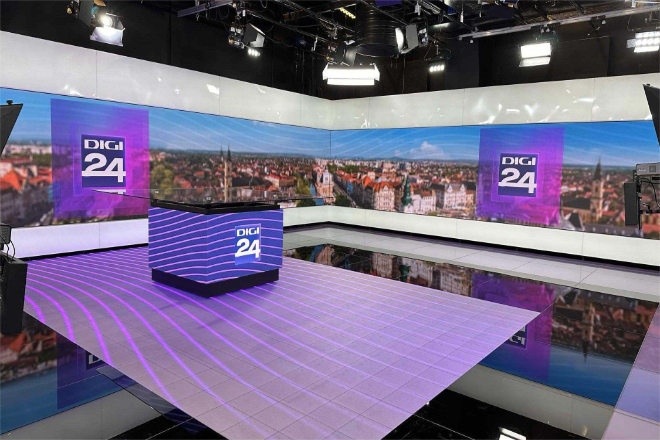
LEDディスプレイはスタジオにおける「トランスフォーマー」のような存在です。柔軟な接続とカスタマイズ機能により、テレビスタジオで際立つ存在感を放ちます。
このスクリーンは、様々な形やサイズに組み立てられるだけでなく、プログラムのテーマやスタイルに合わせて、表示コンテンツや視覚効果を自由にカスタマイズできます。まさに創造性のために生まれたと言えるでしょう。
1)バラエティ番組の「変化し続けるステージ」
バラエティ番組では、 ステージ 効果は特に重要です。LEDディスプレイスクリーンは接合の柔軟性が高いため、様々な特殊形状のスクリーンに簡単に組み立てることができます。
たとえば、円形、円弧、波状、さらには巨大な「タイムトンネル」に組み立てられるものもあります。
例えば、アメリカの「アメリカズ・ゴット・タレント」のステージでは、巨大な半円形の背景を形成するために LED ディスプレイスクリーンがよく使用され、その上でさまざまな特殊効果が演じられます。
例えば、星空や海、森など、ステージ全体が一瞬にしてファンタジーの世界になります。
このユニークな舞台効果は、観客を輝かせるだけでなく、出場者がパフォーマンスにさらに参加しているように感じさせます。
2)特別プログラムにおける「テーマカスタマイズ」
特別なプログラムの場合、LED ディスプレイ画面のカスタマイズ機能はさらに強力になります。
たとえば、歴史や文化に関する特別番組では、番組の内容に応じて背景テーマをカスタマイズできます。
例えば、BBCのドキュメンタリーシリーズ「文明」では、スタジオがLEDディスプレイスクリーンを使用して古代文明の壁画や古代の建物などの背景をカスタマイズし、司会者が説明しているときにまるで古代文明の中にいるかのように見せています。
このカスタマイズされた背景は、視覚的なインパクトを高めるだけでなく、視聴者がプログラムに没頭し、歴史の魅力を感じることを可能にします。
3). 柔軟性がもたらす無限の創造空間
この柔軟性とカスタマイズ機能により、プログラム制作に無限の創造空間が提供されます。
番組制作チームは独自のアイデアでユニークな視覚効果を生み出すことができます。
たとえば、一部の音楽プログラムでは、曲のスタイルに応じて画面のコンテンツをカスタマイズできます。
ロック音楽なら、スクリーンには力強い光と影の効果とダイナミックな映像が映し出されます。クラシック音楽なら、スクリーンには優雅なクラシック模様と柔らかな光と影が映し出されます。
この多様で創造的な空間により、プログラムは従来の舞台デザインに限定されず、コンテンツに応じていつでも変更でき、観客に新しい視覚体験をもたらすことができます。
利点3: 画像が鮮明で見やすい
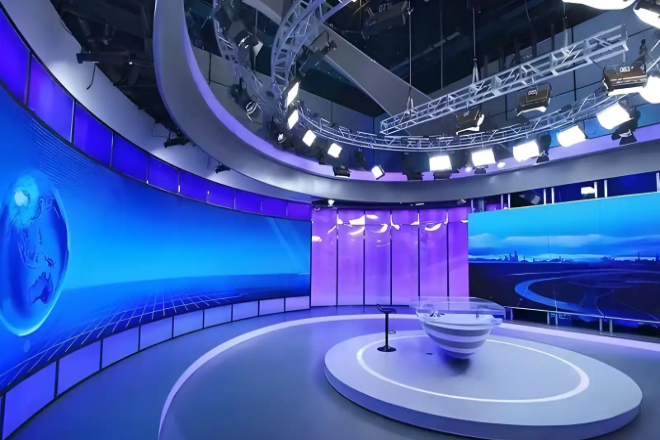
スタジオでは照明条件が頻繁に変化します。時には照明が非常に明るくなることもありますが、時には柔らかな雰囲気を演出する必要があります。
この場合、ディスプレイデバイスが十分に「ハードコア」でないと、画像がぼやけやすくなります。
しかし、LEDディスプレイは「輝度 「専門家向け」。高輝度、高コントラストにより、あらゆる環境でも鮮明な画像を維持し、視聴者に明瞭な映像を提供します。
強い光の下では、通常のディスプレイ画面は「数秒で消えてしまう」可能性があり、画像が灰色になってしまいます。
しかし、LEDディスプレイは違います。まるで「アンチグレアシールド」を内蔵しているかのような高輝度で、強い光の中でも鮮明な映像を映し出します。
たとえば、大規模なイベントのスタジオでは、現場の照明がまぶしい場合でも、観客は LED スクリーン上のコンテンツをはっきりと見ることができます。
LEDディスプレイの高コントラストもまた、このディスプレイの「キラー」です。非常に深い黒と非常に明るい白を再現できるため、映像に非常に重層的な印象を与えます。
たとえば、星空、山、街の夜景などの複雑な画像や動画を表示する場合、高コントラストの LED ディスプレイを使用すると、これらの画像の詳細がより鮮明になり、重要な情報がより簡単に強調表示されます。
海外でとても有名な「グッドモーニングアメリカ」という番組があるのですが、そのスタジオではLEDディスプレイが使われています。
この番組は午前中に放送されることが多く、スタジオ内の照明状況が大きく変わります。
柔らかな朝の光だったり、明るい室内光だったり。どんな状況でも、LEDディスプレイは鮮明な画像を保ちます。
司会者の表情、ニュースの内容、背景の細かい部分まで視聴者にはっきりと見えるようにします。
この安定した画像パフォーマンスにより、プログラムはよりプロフェッショナルに見え、視聴者の視聴体験が向上します。
利点4:観客の参加意識を高めることができる
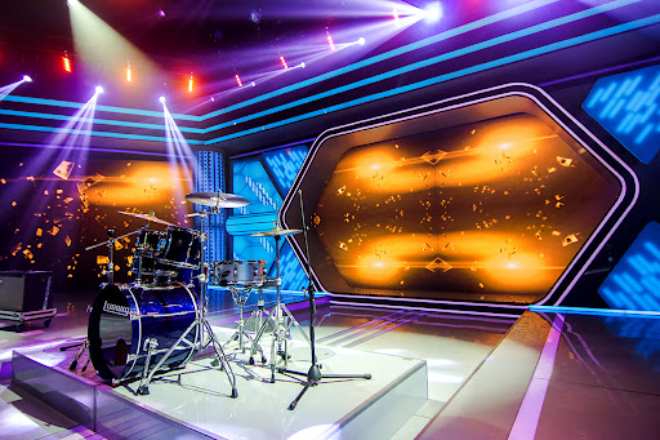
現代のテレビ番組では、インタラクティブ性がますます重要になっています。視聴者はただ座って番組を観るだけでは満足しなくなっています。
彼らは番組に参加して、ゲストやホストと一緒に「遊び」たいと思っています。
LED ディスプレイの低遅延特性は「スーパーアクセラレータ」のようなもので、画像や動画を遅延やフリーズなく瞬時に伝送できます。
これは、ライブ プログラムやリアルタイムのインタラクティブ セッションにとっての「救世主」です。
インタビュー番組では、視聴者はソーシャルメディアを通じてゲストにメッセージを送ったり、質問したり、意見を述べたりすることができます。
低遅延の LED ディスプレイにより、ゲストは観客のフィードバックをリアルタイムで確認できるため、時間内に観客に応答できます。
特にやり取りがスムーズになり、視聴者は自分の意見が尊重されていると感じ、参加意識が一気に高まります。
さらに、LED ディスプレイ スクリーンはタッチ テクノロジーと連携して機能し、視聴者がタッチ スクリーンを通じて直接プログラムに参加できるようになります。
たとえば、一部のバラエティ番組では、視聴者はタッチスクリーンを通じてお気に入りの出場者に投票したり、番組内の小さなゲームに参加したりすることができます。
このインタラクティブな方法は楽しいだけでなく、視聴者がプログラムの一部であると感じさせ、プログラムの楽しさと魅力を大幅に高めます。
海外には「アメリカンアイドル」という、視聴者の参加を特に重視した番組があります。
ショーの LED ディスプレイ スクリーンでは、観客は出場者のパフォーマンスをリアルタイムで見ることができるだけでなく、タッチ スクリーンを通じて投票し、心の中で「歌手の王」を選ぶこともできます。
このインタラクティブな方法により、視聴者はゲームの結果を決定する権利を持っていると感じ、参加意識が高まり、番組はより多くの視聴者を魅了しました。
メリット5:運用負担を軽減できる
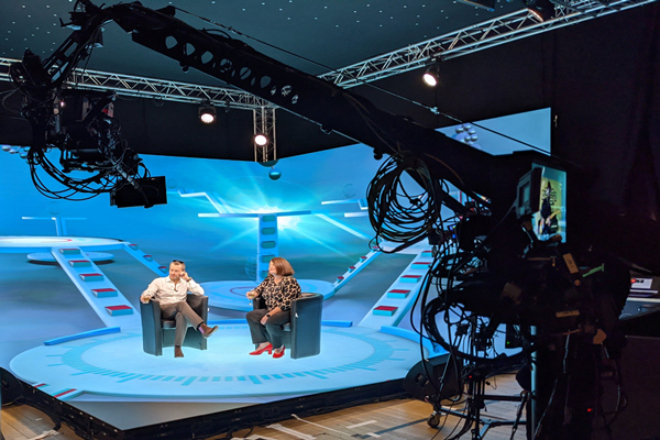
テレビ局にとって、機器の信頼性と維持費は特に重要です。機器に頻繁にトラブルが発生すると、番組の放送が遅れるだけでなく、修理に多額の費用がかかります。
LEDディスプレイは、この点において特に安心です。高度な放熱技術と安定した回路設計を採用しているため、常時点灯でもスムーズに動作し、故障もほとんどありません。
この「信頼できる」性能により、機器メンテナンスの回数が減るだけでなく、番組制作もスムーズに進めることができます。
さらに、LEDディスプレイは長寿命でメンテナンスが容易です。従来のディスプレイ装置とは異なり、ランプは定期的に交換する必要があり、キャリブレーションにも時間がかかります。
LEDディスプレイについては、あまり心配する必要はありません。定期的に埃を拭き取り、簡単な点検を行うだけで、常に良好な状態でお使いいただけます。これにより、テレビ局はメンテナンスにかかるコストと時間を大幅に節約できます。
たとえば、英国放送協会 (BBC) などの一部の海外テレビ局は、スタジオで LED ディスプレイを何年も使用していますが、大きな問題は発生していません。
保守担当者は、機器の正常な動作を確保するために、スクリーンを清掃し、ラインを定期的にチェックするだけで済みます。
メンテナンスの必要性が低いため、テレビ局のスタッフは機器のメンテナンスではなく番組制作に集中できます。
メリット6:スタジオレイアウトを最適化できる
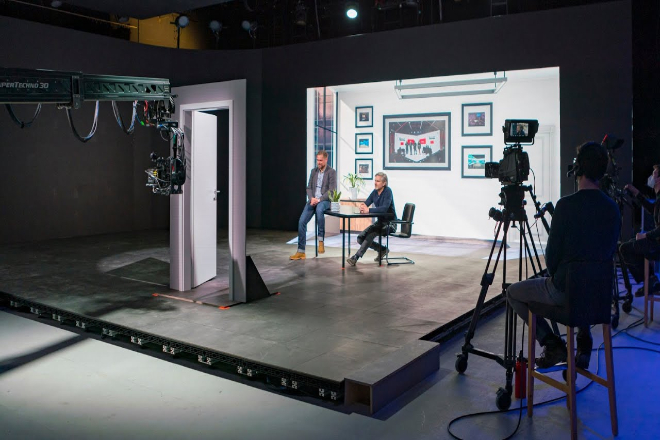
スタジオ内のスペースは限られているため、機材のサイズや設置方法は特に重要です。
LEDディスプレイはまるで「空間の魔術師」のようです。軽量で薄型設計のため、設置スペースを非常に節約でき、スタジオに余分な負担をかけません。
さらに、設置やメンテナンスが簡単なだけでなく、スタジオの見た目もすっきりとモダンになります。
例えば、超薄型LEDディスプレイはスタジオの壁に直接取り付けることができ、床面積を全く占有しません。これにより、スタジオのレイアウトにさらなる可能性が生まれます。
例えば、背景の壁にスクリーンを設置したり、ステージの両側に補助スクリーンを設置したりすることで、スペースを取らずに視覚効果を高めることができます。
この柔軟な設置方法により、スタジオのスペースをより効率的に活用できます。
さらに、LED ディスプレイは軽くて薄いため、スタジオの全体的なデザインに簡単に統合できます。
たとえば、現在多くのスタジオはシンプルでモダンなスタイルを追求していますが、軽量で薄い LED ディスプレイはまさにこのデザイン要件を満たしています。
壁や天井と完璧にマッチし、スタジオ全体をより美しく、より技術的に見せます。
この点において特に優れた成果を上げているテレビ局がいくつかあります。例えば、米国のCNNスタジオでは、背景の壁に直接埋め込まれた超薄型LEDディスプレイを使用しています。
これにより、スタジオはより広く見えるだけでなく、よりシンプルでモダンなスタイルになります。視聴者はテレビを見る際に、乱雑な機器に気を取られることなく、番組内容に集中できるようになります。
メリット7:業務効率を向上できる
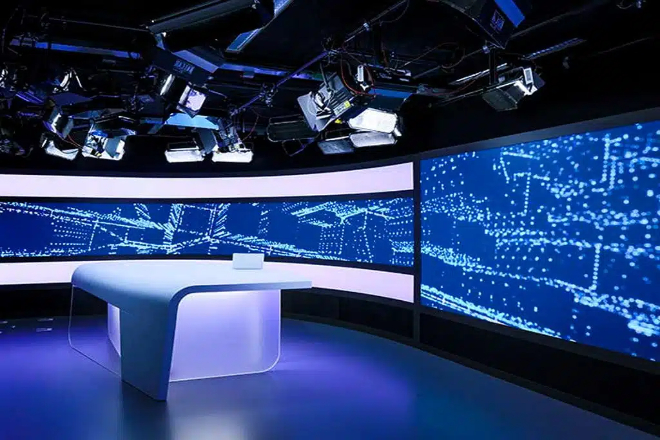
現代のテレビスタジオでは、時間は効率であり、効率こそが命です。機器の操作が複雑で管理が難しいと、作業が遅れてしまいます。
LEDディスプレイはまるで「スマートアシスタント」のようです。インテリジェントな制御システムは非常に便利です。
ワンクリックで表示内容を切り替え、パラメータを調整できます。操作は高速かつシンプルです。
たとえば、スタジオでプログラムを切り替える場合、背景画像もそれに応じて変更する必要があります。
以前は、機器を手動で調整する必要があり、時間がかかり、手間がかかっていました。
LED ディスプレイのおかげで、スタッフは制御ソフトウェアをクリックするだけで、次のプログラムの背景画像にすぐに切り替えられるようになりました。
これにより、プログラム間の移行がシームレスになり、作業効率が直接最大化されます。
さらに、LED ディスプレイは、単純に「リモート コントロール アーティファクト」であるリモート管理機能もサポートしています。
ネットワーク接続により、テレビ局のスタッフはスタジオにいなくてもいつでも機器を監視・管理できます。
機器の稼働状況をリアルタイムで確認できるため、トラブル発生時にも番組の放送に影響が出る心配なく、迅速に対応できます。
たとえば、米国の NBC などの大手テレビ局の中には、全国に複数のスタジオを持つところもあります。
リモート管理機能により、技術者は本社オフィスの各スタジオの LED スクリーンを簡単に管理できます。
設備がどの都市にあっても、リアルタイムで状況を把握し、問題を適時に解決できるため、運用効率が大幅に向上します。
8. 結論
テレビスタジオに LED ディスプレイ スクリーンを導入したことで、視聴者の視聴体験が変わっただけでなく、テレビ番組制作の革新と発展も促進されました。
繊細な画像表現、柔軟でクリエイティブな表示、安定したパフォーマンス、効率的な操作管理により、現代のスタジオに欠かせないツールとなっています。
最後に、LEDディスプレイスクリーンについてさらに詳しく知りたい場合は、 ご連絡ください。
あなたは興味があるかもしれません:
Other articles about studio LED display:
